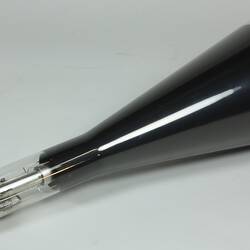

Luckily for Plücker, Geissler was already interested in these tubes from the experiments of his brother Friedrich in the Netherlands. With this pump, he hoped to reach very low-pressure levels inside the tube. In 1855, Plücker asked Geissler to construct a hand-crank mercury pump and glass tubes that could contain a superior vacuum.

His research made him believe this would allow him to concentrate light for his spectral research. It was at this time that Plücker asked Geissler to make him an apparatus for evacuating a glass tube. In 1847, he began research on the behavior of crystals in a magnetic field, establishing results central to a deeper knowledge of magnetic phenomena. In the 1840s, he turned away from mathematics and concentrated his attention on physics. Julius Plücker, on the other hand, was a famous German mathematician who made fundamental contributions to analytic and projective geometry. Thomson, Ferdinand Braun, and countless others Original Use Displaying images Cost varies Quick Facts Created 1897 Creator Julius Plücker, Arthur Schuster, William Crookes, J. It was here that he worked as an instrument maker for the production of physical and chemical instruments. Eventually, in 1852, Geissler decided to settle down in a workshop of his own. Born in Igelshieb, Thuringen and descended from a long line of craftsmen in the Thüringer Wald and in Böhmen, Geissler had worked as an instrument maker with his brothers throughout Germany and the Netherlands for many years. The history of cathode ray tube can be followed back to at least 1854 when the skilled German glassblower and mechanic Johann Heinrich Wilhelm Geißler - also known as Heinrich Geissler - was asked to design an apparatus for evacuating a glass tube by Julius Plücker, the professor of mathematics and physics at Universität Bonn (University of Bonn).

This puts a serious limit on the size and the shape of a CRT display, which explains why LCD and LED eventually left CRT in the dust. Because CRTs require thick glass to safely and effectively create and maintain a vacuum, cathode ray tubes weigh quite a bit.These storage tubes are CRTs made to hold onto an image as long as there’s power being supplied to the tube. While we think of CRT as display technology, it can also be used for storage.In 1855, Heinrich Geissler was awarded a gold medal by the Exposition Universelle (World Exhibition) in Paris due to his excellent work on fine glass - including what would eventually be known as the cathode ray tube.This force could be provided only result from a collision with a massive target or from an interaction with an electric or magnetic field of great strength.Ĭonclusion - It was discovered that every atom contains a nucleus (whose diameter is of the order 10-14m) where all of its positive charge and most of its mass are concentrated in a small region called an atomic nucleus.Inventor of the cathode ray tube. To deflect the alpha particle backward, there must be a very large force. If an alpha particle collides with an atom, it would fly straight through, its path being deflected by at most a fraction of a degree. Because of their relatively much greater mass, alpha particles are not significantly deflected from their paths by the electrons in the metal’s atoms. Alpha particles, which are about 7300 times more massive than electrons, have a positive charge of +2e. Alpha particles are energetic nuclei of helium (usually about 6 MeV). A narrow collimated beam of alpha particles was aimed at a gold foil of approximately 1 μm thickness (about 10,000 atoms thick). Lord Rutherford’s experiment on discovery of atomic nucleus:Įxperiment - To direct energetic alpha particles at a thin metal foil and measure how an alpha particle beam is scattered when it strikes a thin metal foil.These positively charged particles are protons. When an electric discharge is passed through this tube, a new type of rays is produced from the anode passing through the holes of positive cathode, they are anode rays.Ĭonclusion - Anode rays are made of positively charged particles because they were affected by magnetic fields in a direction opposite to that of cathode rays. Goldstein’s experiment which led to discovery of protons:Įxperiment - The figure shows a modified cathode ray tube with a perforated cathode.


 0 kommentar(er)
0 kommentar(er)
